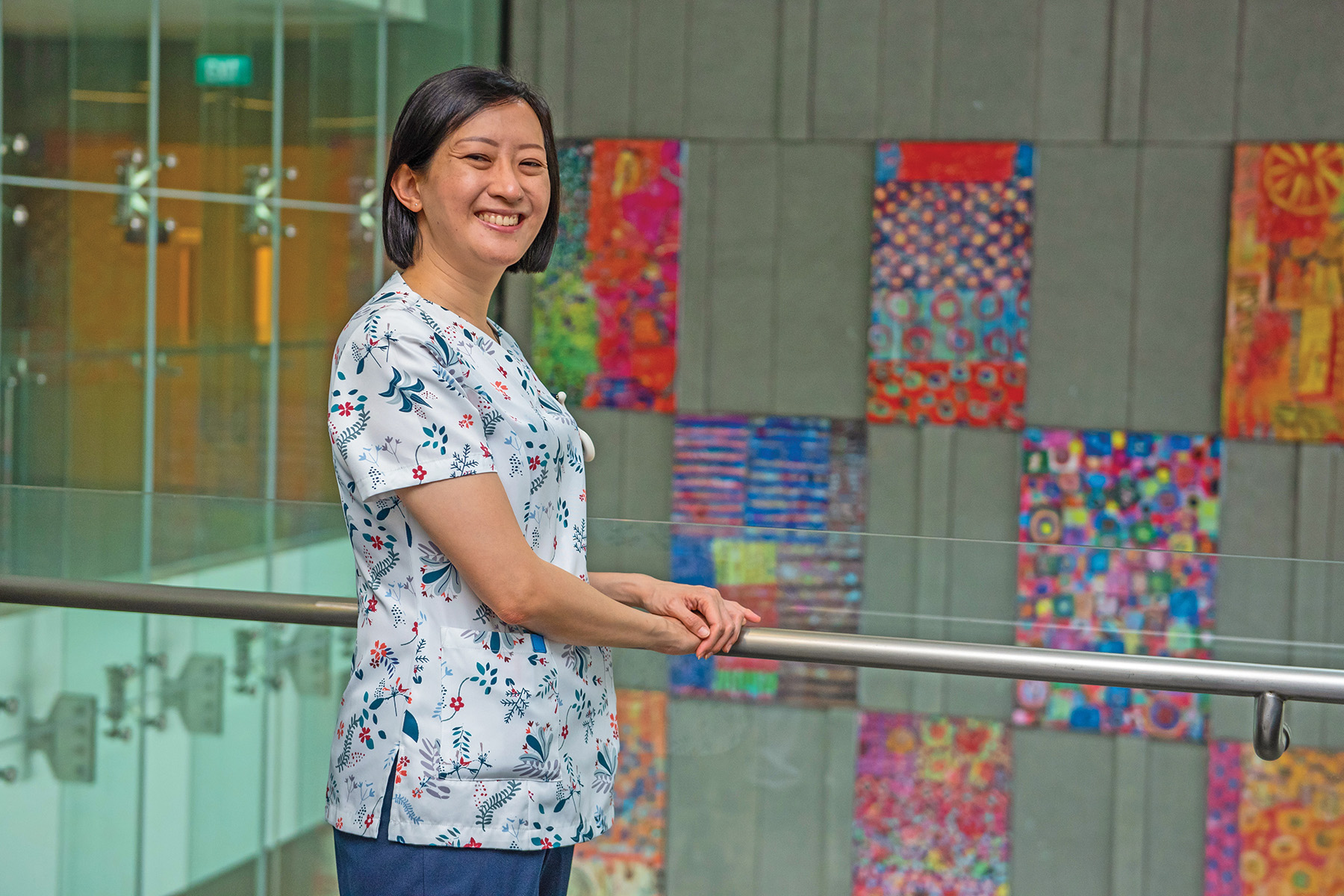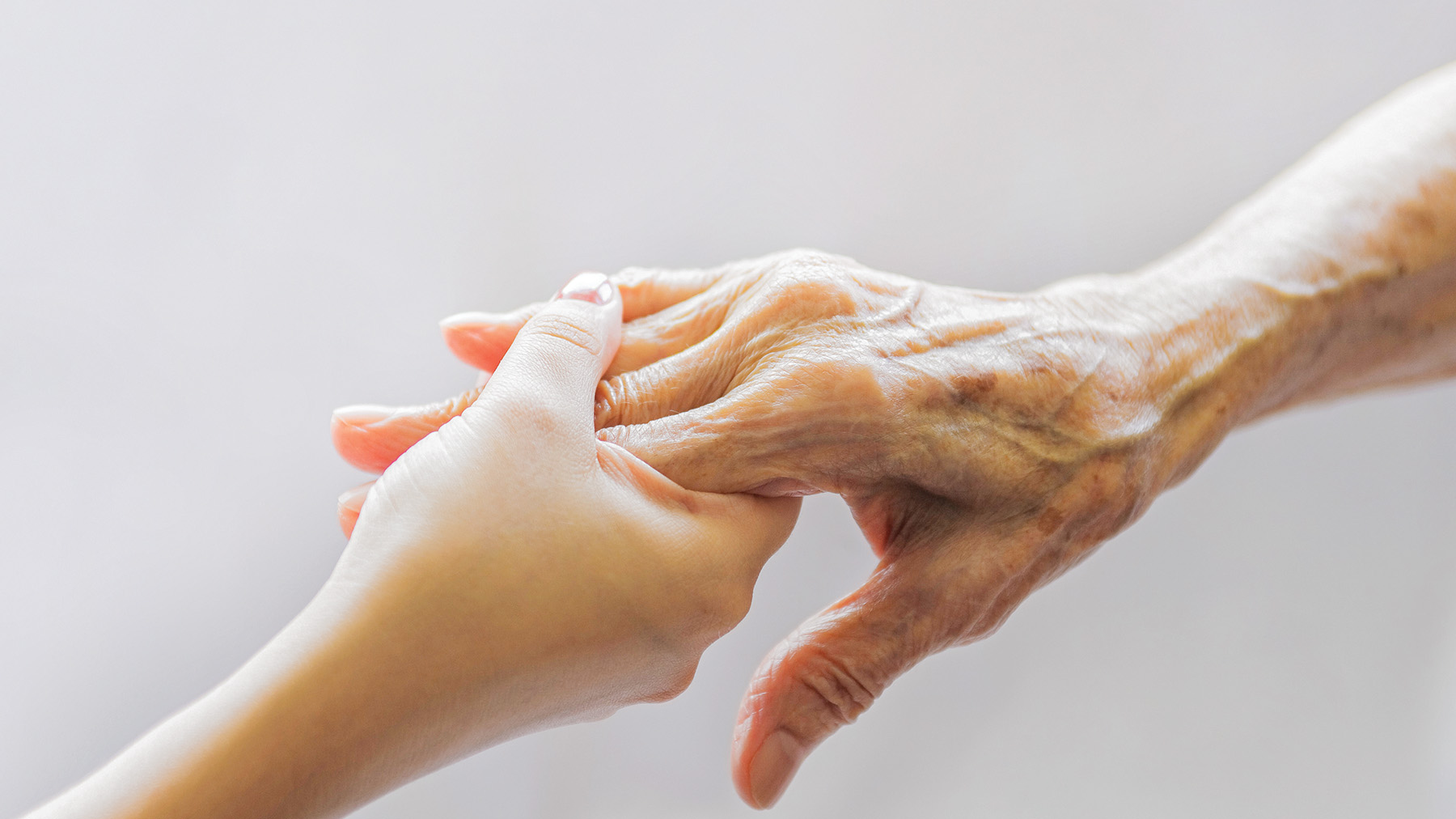
Issue 43 / August 2022
Nursing
With an End-of-life Doula, No One Has to Die Alone

Joanne Gan was six years old when her grandfather died. His passing troubled her for a long time, and she would avoid any talk of death and dying.
ver the years, however, she has overcome her fear and has become a volunteer, accompanying strangers on the final stretch of their lives.
Joanne, a third-year undergraduate in the part-time Bachelor of Science (Nursing Practice) programme, volunteers as an end-of-life doula at the Institute of Mental Health (IMH) in Hougang. “Doula” is a Greek word meaning “female helper”.
“I make time to visit selected patients, or persons with mental health issues who have been diagnosed with a terminal illness or are deteriorating from old age,” says the full-time nurse at Assisi Hospice.
Joanne, who is in her 30s, began volunteering at IMH in 2014. When the No One Dies Alone programme was started in 2018, she knew it was something she wanted to be a part of. The IMH took in its first patient for this programme in January of the following year.
In her role, Joanne provides physical, emotional and informational support to the dying who do not have any next-of-kin. As their conditions deteriorate towards their final days, Joanne stays at their bedside to accompany them in their last moments.
As grim as it may seem, Joanne said she finds her role meaningful, and fondly remembers her interactions with patients.
One key approach in befriending any patient is through the element of touch, which is thought to be the first of the senses a person develops, said Joanne.
“For the longest time, some of these patients might have forgotten what it was like to have a family or friend figure in their lives. It might mean a lot for the patients just to have a ‘No One Dies Alone’ volunteer sit with them, and simply talk or hold their hand,” she said.
Joanne also uses music to form connections. She learnt to play the harp in 2018 after learning about the instrument’s effectiveness in end-of-life care, and usually carries a small harp with her when she goes to IMH.
Connecting through music
“Madam Tan was a lady in her 80s who would sing Christian songs and go into prayer whenever I played the harp for her,” Joanne shared.
Despite losing her ability to walk as her health declined, Madam Tan’s strong Christian faith helped her remain optimistic and joyful, and she would greet volunteers with words of blessings, before her passing in mid-2019.
Another patient who left an impression on Joanne was Mr Goh, who was in his mid‑60s when he died.
“Mr Goh was a gentleman who loved 4D and Toto so much, so I brought him actual 4D and Toto betting slips for him to look at and touch,” says Joanne. “Churning out four-digit numbers to volunteers and playing cards brought him much joy in his final days.”
“For the longest time, some of these patients might have forgotten what it was like to have a family or friend figure in their lives. It might mean a lot for the patients just to have a ‘No One Dies Alone’ volunteer sit with them, and simply talk or hold their hand.”
She visited him over Christmas last year, to accompany him on an occasion which most people would typically spend with family or friends.
It turned out to be his final Christmas.
Mr Goh died a few days later, just five minutes before Joanne reached his ward.
“I was calm when I arrived, but just felt sad that he had no family or friends by his side, except for another volunteer and me. We had but just a few weeks to build our bond with him, prior to his passing,” she recalls.
After the patients’ deaths, Joanne also attends their funerals. She explained that apart from the undertakers, these individuals usually have no one else to send them off at the crematorium or at a sea burial.
Joanne attributes her desire to enter the field of end-of-life care, to the female role models in her family.
“My late grandmother—a young widow back in the 1950s—was ostracised by her in-laws as widows were perceived to bring bad luck to the family. However, she single-handedly raised four young children, and started a church in a small town in Malaysia—which still exists today—by herself. She was a church preacher who would spend time, even when she was already in her 80s, to visit socially isolated people,” she says.
Joanne’s mother was a nurse before she retired, and now spends her time helping the less fortunate in the community. For example, she recently helped secure food rations for families which were financially affected by the pandemic.

“My aunt was a sociologist who worked on a PhD related to married Australian women living with mental health conditions, after which she also taught a module on death and dying at Monash University, during the 1970s and early 1980s. She certainly made an impression as a young migrant Asian woman, as that period was when women were just beginning to champion for a more egalitarian society with equal rights,” Joanne adds.
And there is also a more personal side to her decision to enter the sector.
Her father and uncle are both cancer patients who had to endure many months of radiotherapy treatment, before their illnesses were brought under remission.
“The decision to go into the field of end-of-life care was for the purpose of learning how to care for my own loved ones, because parents, aunts and uncles don’t stay young forever,” says Joanne.
However, the challenge of removing stigma associated with providing end-of-life care for persons with mental health issues remains. The challenge is two-fold, because many people are still uncomfortable about confronting both issues, says Joanne.
Many individuals with mental health issues are ostracised or looked at askance because of their illness, she noted.
“Adding salt to the wound is the taboo subject of death and dying,” she adds.
“‘Who in their right mind would want to make friends with a dying mental patient? What can you do with someone who’s not able to hold a proper conversation with you?’ some might think.”




